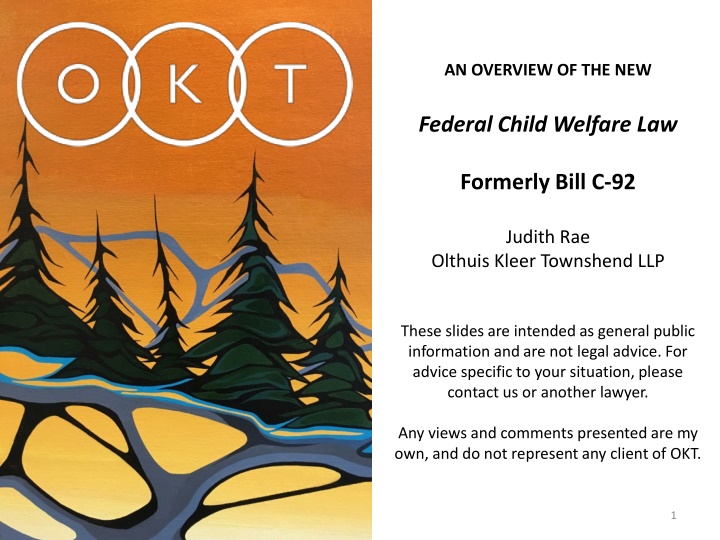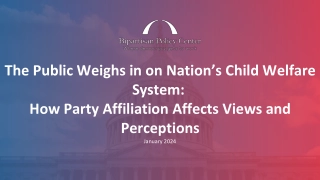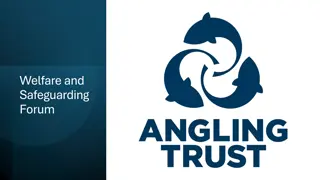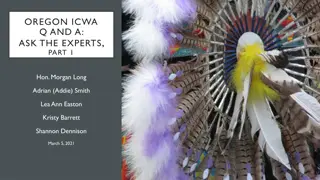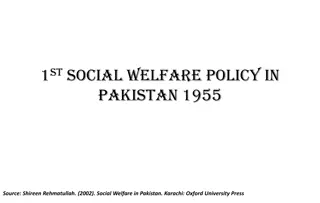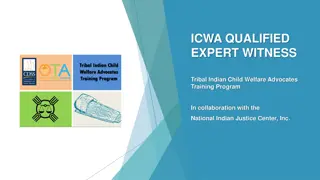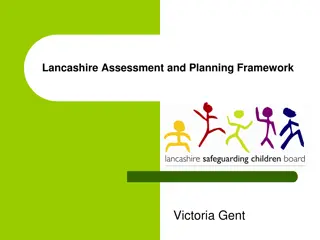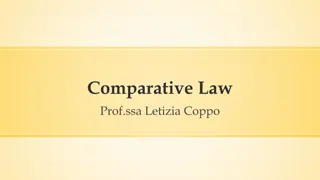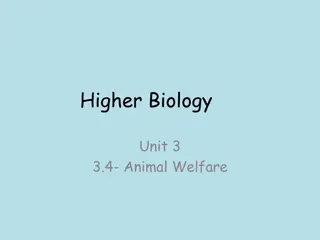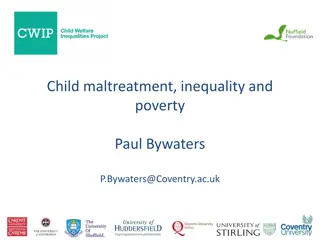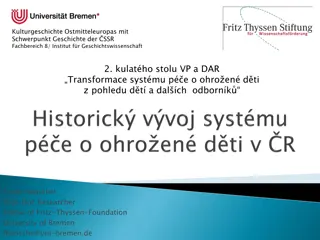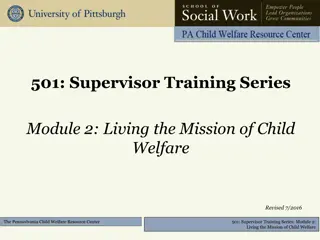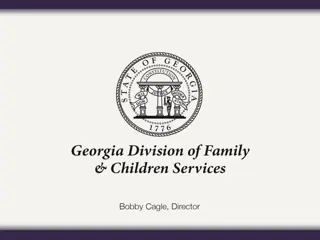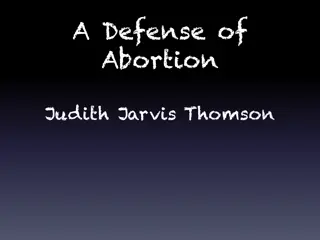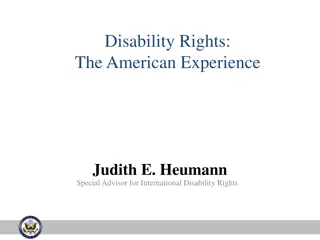Overview of the New Federal Child Welfare Law by Judith Rae Olthuis Kleer Townshend LLP
These slides provide general public information on the new Federal Child Welfare Law, formerly Bill C-92. Presented by Judith Rae Olthuis Kleer Townshend LLP, this overview is not legal advice but aims to inform the audience about this significant legislation.
Download Presentation

Please find below an Image/Link to download the presentation.
The content on the website is provided AS IS for your information and personal use only. It may not be sold, licensed, or shared on other websites without obtaining consent from the author.If you encounter any issues during the download, it is possible that the publisher has removed the file from their server.
You are allowed to download the files provided on this website for personal or commercial use, subject to the condition that they are used lawfully. All files are the property of their respective owners.
The content on the website is provided AS IS for your information and personal use only. It may not be sold, licensed, or shared on other websites without obtaining consent from the author.
E N D
Presentation Transcript
AN OVERVIEW OF THE NEW Federal Child Welfare Law Formerly Bill C-92 Judith Rae Olthuis Kleer Townshend LLP These slides are intended as general public information and are not legal advice. For advice specific to your situation, please contact us or another lawyer. Any views and comments presented are my own, and do not represent any client of OKT. 1
The Federal Child Welfare Law Full name: An Act respecting First Nations, Inuit and M tis children, youth and families, SC 2019, c 24 Previously: Bill C-92 Passed by Canada June 2019 Comes into force January 1, 2020 Link: https://laws-lois.justice.gc.ca/eng/acts/F-11.73/FullText.html 2 Your sovereignty. Your prosperity. Our mission.
Historical Context Residential schools Sixties Scoop Inter-generational trauma Insufficient support for prevention services Millenium scoop Huge over-representation of First Nations children in care (and to lesser extent, other Indigenous children) Landmark win (2016) in human rights complaint on the federal government s underfunding of child welfare services for First Nations 3 Your sovereignty. Your prosperity. Our mission.
Immediate Context Truth and Reconciliation Commission on Indian Residential Schools, Call to Action #4 (2015): We call upon the federal government to enact Aboriginal child welfare legislation that establishes national standards Canada holds a national emergency meeting on First Nations child welfare in January 2018: Then-Minister Jane Philpott unveils Canada s 6-point plan that includes Supporting communities to draw down jurisdiction and explore the potential for co-developed federal child welfare legislation 4 Your sovereignty. Your prosperity. Our mission.
Process of making it Canada has never made child welfare legislation. Its lack of expertise and experience on this subject was apparent. There are also challenges given that the legislation cuts across all provinces (e.g. concepts and terms are not consistent). And, the actual development of the legislation felt very rushed. Canada said it was co-developed with Indigenous peoples, though many dispute that. It had the consent of national organizations (AFN, ITK, MNC) but not Indigenous nations. 5 Your sovereignty. Your prosperity. Our mission.
Summary What does it do? How does it work? 6 Your sovereignty. Your prosperity. Our mission.
C-92 Does 2 Things 1 2 Sets out a small number of federal rules on Indigenous child welfare - about 10 substantive laws - content emphasizes prevention, etc. - overlays on top of both provincial and Indigenous laws - mandatory - in force Jan 1, 2020 Recognizes inherent jurisdiction of Indigenous peoples in child and family services, and clears a path that can assist in the exercise of that jurisdiction - Optional - Can be exercised at any time (Jan 1st onward?) 7 Your sovereignty. Your prosperity. Our mission.
There may be multiple Indigenous laws, phasing in a different times Indigenous laws sometimes partially applied, e.g. in communities, or by own agencies, but not fully respected by courts, other governments, other service providers, etc. May be displaced, depending on the content of Indigenous laws Your sovereignty. Your prosperity. Our mission.
1. The Federal Rules (Minimum Standards) There are about 10 sections of the federal law with substantive rules about child welfare: sections 9-17 of Act. The way it works is pretty confusing. These federal rules layer on top of Provincial and Indigenous laws. Both or all three apply, unless there s a conflict or inconsistency . All 10 will prevail over provincial law. 6 of them would prevail over an Indigenous law too: s. 22(1). 9 Your sovereignty. Your prosperity. Our mission.
1. The Federal Rules (Minimum Standards) Some First Nations object in principle to the imposition of these rules over Indigenous laws. Though while some of the language is confusing, or constraining, most of the content is fairly mild and/or could be positive. Starting Jan. 1st 2020, it will generally provide some benefits over provincial legislation. The degree of benefit depends on the province. It depends on what the provincial baseline is. In some cases, the benefits will not be dramatic, in others, the difference will be more noticeable. Provincial/territorial laws will continue to provide the primary legal framework of child welfare. Cases will continue to be heard in provincial courts or wherever they usually go, and most processes will stay the same. 10 Your sovereignty. Your prosperity. Our mission.
1. The Federal Rules (Minimum Standards) s. 9 Principles (inform interpretation of the standards and of C-92 generally): (1) best interests; (2) cultural continuity; (3) substantive equality s. 10 best interests of the child s. 11 effect of services some general points, mandatory language s. 12 notice to Indigenous governments, parents, caregivers s. 13 right to representations in court for Indigenous governments; right to party status in court for parents, caregivers s. 14 priority to prevention before other services s. 15 limiting use of socio-economic conditions as a driver for removals s. 15.1 requires reasonable efforts to keep child at home before removal s. 16 priority of placement, considering siblings, reassessment of family unity s. 17 promoting emotional ties between child and family ss. 10-15 prevail over an Indig. law The end of these slides has a summary of these 10 federal rules. The analysis of their impact will differ by province/territory. 11 Your sovereignty. Your prosperity. Our mission.
2. Jurisdiction recognition Affirmation 18 (1) The inherent right of self-government recognized and affirmed by section 35 of the Constitution Act, 1982 includes jurisdiction in relation to child and family services, including legislative authority in relation to those services and authority to administer and enforce laws made under that legislative authority. 12 Your sovereignty. Your prosperity. Our mission.
2. Jurisdiction Pathway There s a process to exercise it: Give notice to Canada and Province(s) 1 Make reasonable efforts to negotiate a Coordination Agreement (including funding) 2 Can come into force after a Coordination Agreement is made, or after 1 year, without an agreement, if reasonable efforts were made 3 The Indigenous law then has the same force as federal law 13 Your sovereignty. Your prosperity. Our mission.
2. Jurisdiction What law applies when Once in force using the C-92 process: The Indigenous law also has the force of federal law The Indigenous law takes precedence over Provincial law could displace all or some both can apply, but in a conflict or inconsistency, the Indigenous Law prevails The Indigenous law takes precedence over most federal law, with exceptions (these are said to prevail over the Indigenous law): o ss. 10-15 of C-92: six of the federal rules o s. 23 of C-92: a general best interests override clause (problematic) o Human rights (Charter & Canadian Human Rights Act) 14 Your sovereignty. Your prosperity. Our mission.
$$ Fiscal arrangements under a Coordination Agreement must be sustainable, needs-based and consistent with the principle of substantive equality s. 20(2)(c) brings in language similar to Canadian Human Rights Tribunal rulings (this was a positive update during review of the bill) But funding outside of Coordination Agreements is not addressed. Funding for development of Indigenous laws, and for negotiation of Coordination Agreements is also not addressed in the Act. Your sovereignty. Your prosperity. Our mission.
Who makes Indigenous laws in C-92? Indigenous governing bodies. Really it is up to Indigenous governments to decide. C-92 is silent and flexible on who this is. Your sovereignty. Your prosperity. Our mission.
Could multiple systems of laws apply to the same agency? YES. Question will be child by child. Could multiple laws apply to the same child? KIND OF YES. C-92 federal law will always apply, then Indigenous law if applicable, which could displace provincial law in whole or in part. If multiple Indigenous laws could be relevant, C-92 says to look for stronger ties to the child. Your sovereignty. Your prosperity. Our mission.
Sections 9 17 from C-92 the federal child welfare law, i.e. the federal rules (so-called minimum standards ) with comparison to Ontario s CYFSA Your sovereignty. Your prosperity. Our mission.
s. 9 - Principles Direction as to how the Act is to be interpreted Based on 3 principles best interests of the child; cultural continuity; substantive equality CYFSA does not have such principles, does not include substantive equality, but has some other similar parts in preamble, other purposes , etc. Does not prevail over Indigenous law Your sovereignty. Your prosperity. Our mission.
s. 10 Best Interests 10(1) requires best interests be a primary consideration wherever a decision or action is taken; also best interests are paramount consideration in a child apprehension 10(2) primary consideration is to safety, security and wellbeing as well as ongoing relationships with family, community and connection to culture Your sovereignty. Your prosperity. Our mission.
s. 10 (contd) 10(3) lists 8 best interest factors to consider; 10(4) says best interests to be construed consistently with Indigenous law applicable, to the extent possible CYFSA makes best interests of child the test for certain decisions (vs a primary or paramount consideration ); does not refer to apprehension but bringing a child to place of safety ; preserving child s cultural identity and connection to community will apply Both provide factors to consider and are overall similar s. 10 prevails over Indigenous law Your sovereignty. Your prosperity. Our mission.
s. 11 Effect of Services Services provided must: Take into account child s needs including physical, emotional and psychological safety, security and well-being Take into account child s culture Allow the child to know his/her family origins Promote substantive equality between child and other children Your sovereignty. Your prosperity. Our mission.
s. 11 (contd) C-92 has mandatory language on this more powerful could be more likely to have an impact CYFSA addresses similar issues, e.g. in other purposes , but not quite the same s. 11 prevails over Indigenous law Your sovereignty. Your prosperity. Our mission.
s. 12 - Notice Before taking any significant measure in relation to a child, service provider must notify child s parent, care provider and Indigenous governing body Personal information about the child, a member of the child s family or care provider is not to be included in the notice other than as necessary to explain the propose measure or as required by the Indigenous governing body s Coordination Agreement. Your sovereignty. Your prosperity. Our mission.
S. 12 Notice (contd) CYFSA has several provisions requiring notice including notice to all bands and Indigenous communities listed by regulation Notice must occur at numerous specified events plus consultation at specified events First Nations do not need to pre-notify that they want notice (!) Under CYFSA, notice includes details also First Nations are parties so they are entitled to full details and disclosure Generally CYFSA is stronger on notice and should continue to apply C-92 s notice provision is more general, so it could apply in some instances not covered by CYFSA i.e. circumstances where notice is not specifically required under CYFSA but there is a significant measure in relation to a child e.g. secure treatment? Note the personal information restriction but I would suggest all relevant information will be necessary to understand the proposed measure. Also, the restriction is limited to the initial notice, not ongoing disclosure. s. 12 prevails over Indigenous law Your sovereignty. Your prosperity. Our mission.
s. 13 Representations and Party Status Child s parent and care provider have right to make representations and have party status Indigenous governing body has right to make representations (does not mention party status) CYFSA already provides automatic full party status to First Nations and listed Indigenous communities This remains in place. Your sovereignty. Your prosperity. Our mission.
s. 13 Representations and Party Status (cont d) C-92 includes new participation right for care providers which is defined as having primary responsibility for providing the day-to-day care Not clear how far this extends I believe it would include a customary care provider. Controversial as to whether it would include a foster parent. CYFSA gives participation rights to parents and some people standing in place of parents before intervention but not those assigned after s. 13 prevails over Indigenous law Your sovereignty. Your prosperity. Our mission.
s. 14 Priority to Prevention Priority to be given to preventive care to support child s family where consistent with best interests of the child Priority to be given to prenatal care which is likely to be in the best interests of the child after birth, to prevent apprehension at birth Your sovereignty. Your prosperity. Our mission.
s. 14 Priority to Prevention (cont d) CYFSA references the importance of prevention as well as least disruptive course of action CYFSA includes a test that a Society must be satisfied that no course of action less disruptive to the child is available C-92 says prevention is to be given priority over other services may be stronger s. 14revails over Indigenous law Your sovereignty. Your prosperity. Our mission.
s. 15 Socio-Economic Conditions Child must not be apprehended solely on the basis of socio-economic conditions to the extent it is consistent with best interest s of the child including poverty, lack of adequate housing or infrastructure, or parent s state of health CYFSA has no comparable provision Supports case for in-home support and addressing family / housing / caregiver conditions without apprehension s. 15 prevails over Indigenous law Your sovereignty. Your prosperity. Our mission.
s. 15.1 Reasonable Efforts Service provider must demonstrate that it has made reasonable efforts to have child continue with parent or other adult member of family before apprehending, unless immediate apprehension is consistent with best interests Places a positive obligation on agencies to make active efforts towards family integrity, and to show that CYFSA has no fully comparable clause; it has least disruptive course of action but no requirement to demonstrate positive action, reasonable efforts s. 15.1 does not prevail over Indigenous law Your sovereignty. Your prosperity. Our mission.
s. 16 Placement Priorities Order for priority of placement to the extent consistent with best interests of child: Parents Family Same Indigenous community/group/people Others Placement with or near siblings must be considered (this may be an added benefit) Reassessment on an ongoing basis to see if child can be returned to parents or extended family Your sovereignty. Your prosperity. Our mission.
S. 16 Placement Priorities (contd) CYFSA has similar order of priority: Priority to parental care or person caring for child prior to intervention; Placement with a member of the child s extended family or another First Nation family unless there is substantial reason to place child elsewhere recommends community placement and prioritizes customary care CYFSA has a system of status reviews s. 16 does not prevail over Indigenous law Your sovereignty. Your prosperity. Our mission.
s. 17 Attachment and Emotional Ties If not placed with a family member, child s attachment and emotional ties to family members are to be promoted where consistent with best interests Creates a positive obligation Your sovereignty. Your prosperity. Our mission.
s. 17 Attachment and Emotional Ties (cont d) CYFSA has clauses on access for parents, communities and persons significant to child, but not necessarily the same positive obligation to promote relationships with each family member unless not in best interests Would include siblings, as well as parents, etc. s. 17 does not prevail over Indigenous law Your sovereignty. Your prosperity. Our mission.
First Nations Responses to C-92 Mixed; First Nations in some provinces quite supportive, others not Chiefs of Ontario called for significant amendments, e.g. to remove interference with jurisdiction and guarantee funding A few improvements made, but many not made COO also concerned about claim of co-developed legislation that did not have their consent Your sovereignty. Your prosperity. Our mission.
Next Steps Important for all First Nations, agencies and others involved in child welfare sector to learn about it and understand it Federal regulations still TBD; transitional processes / tables under consideration leaves a lot of questions since it is coming into force on Jan 1st anyway Overall impact of Phase 1 in Ontario: Small Potential Impact of Phase 2: could be huge much will depend on what First Nations decide to do First Nations & other Indigenous Governments may want to consider their next steps in exercising their jurisdiction, whether using C-92 or otherwise Your sovereignty. Your prosperity. Our mission.
THANK YOU! Judith Rae 416-981-9407 jrae@oktlaw.com www.oktlaw.com 40
